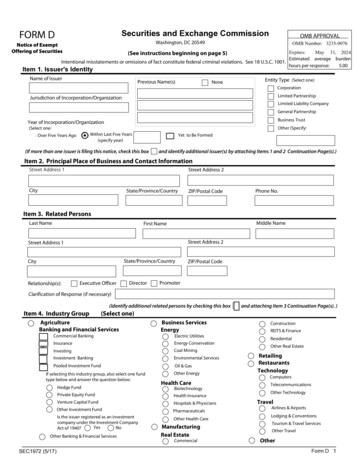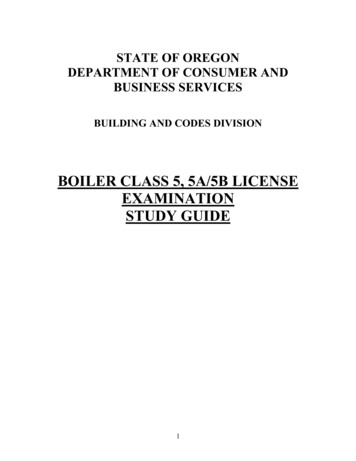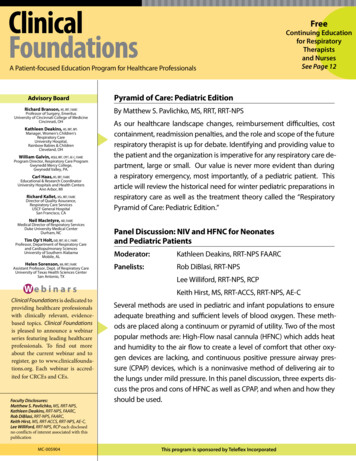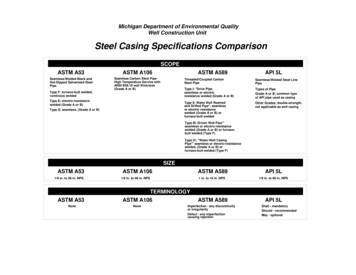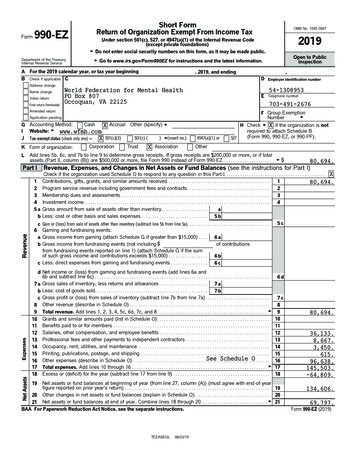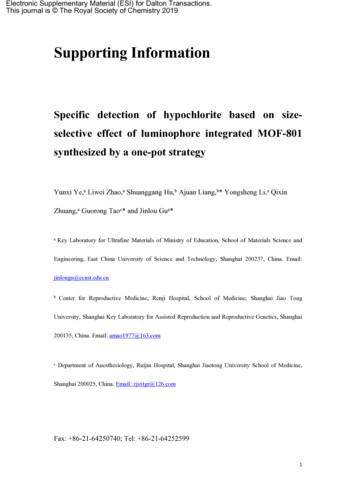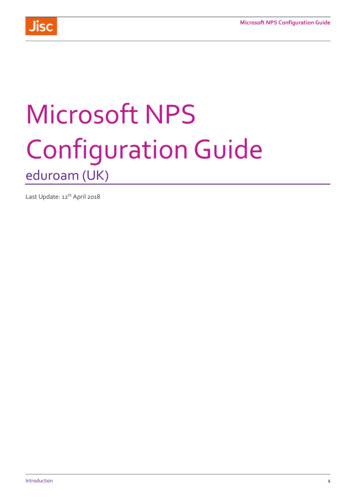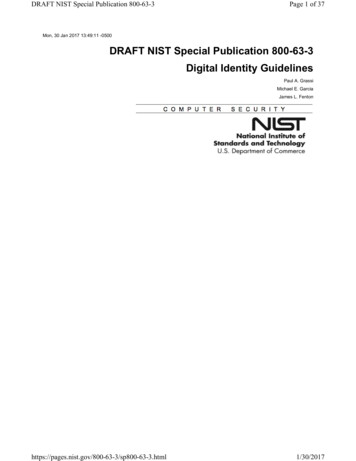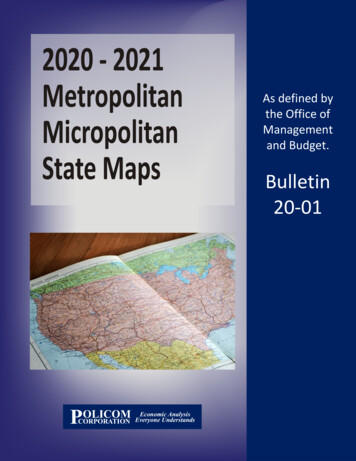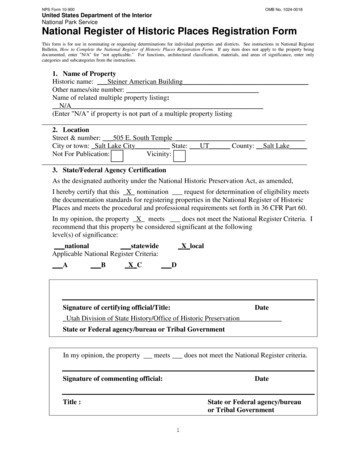
Transcription
NPS Form 10-900OMB No. 1024-0018United States Department of the InteriorNational Park ServiceNational Register of Historic Places Registration FormThis form is for use in nominating or requesting determinations for individual properties and districts. See instructions in National RegisterBulletin, How to Complete the National Register of Historic Places Registration Form. If any item does not apply to the property beingdocumented, enter "N/A" for "not applicable." For functions, architectural classification, materials, and areas of significance, enter onlycategories and subcategories from the instructions.1. Name of PropertyHistoric name: Steiner American BuildingOther names/site number:Name of related multiple property listing:N/A(Enter "N/A" if property is not part of a multiple property listing2. LocationStreet & number: 505 E. South TempleCity or town: Salt Lake City State: UT County: Salt LakeNot For Publication:Vicinity:3. State/Federal Agency CertificationAs the designated authority under the National Historic Preservation Act, as amended,I hereby certify that this X nomination request for determination of eligibility meetsthe documentation standards for registering properties in the National Register of HistoricPlaces and meets the procedural and professional requirements set forth in 36 CFR Part 60.In my opinion, the property X meets does not meet the National Register Criteria. Irecommend that this property be considered significant at the followinglevel(s) of significance:nationalstatewideApplicable National Register Criteria:ABX CX localDSignature of certifying official/Title:DateUtah Division of State History/Office of Historic PreservationState or Federal agency/bureau or Tribal GovernmentIn my opinion, the propertymeetsdoes not meet the National Register criteria.Signature of commenting official:DateTitle :State or Federal agency/bureauor Tribal Government1
United States Department of the InteriorNational Park Service / National Register of Historic Places Registration FormNPS Form 10-900OMB No. 1024-0018Steiner American BuildingSalt Lake, UtahName of PropertyCounty and State4. National Park Service CertificationI hereby certify that this property is:entered in the National Registerdetermined eligible for the National Registerdetermined not eligible for the National Registerremoved from the National Registerother (explain:)Signature of the KeeperDate of Action5. ClassificationOwnership of Property(Check as many boxes as apply.)Private:XPublic – LocalPublic – StatePublic – FederalCategory of Property(Check only one ns 1-6 page 2
United States Department of the InteriorNational Park Service / National Register of Historic Places Registration FormNPS Form 10-900OMB No. 1024-0018Steiner American BuildingSalt Lake, UtahName of PropertyCounty and StateNumber of Resources within Property(Do not include previously listed resources in the ructuresobjects1TotalNumber of contributing resources previously listed in the National Register 06. Function or UseHistoric Functions(Enter categories from instructions.)Commerce/BusinessCurrent Functions(Enter categories from instructions.)Commerce/Professional (Work in Progress)Sections 1-6 page 3
United States Department of the InteriorNational Park Service / National Register of Historic Places Registration FormNPS Form 10-900OMB No. 1024-0018Steiner American BuildingSalt Lake, UtahName of PropertyCounty and State7. DescriptionArchitectural Classification(Enter categories from instructions.)Modern Movement/WrightianModern Movement/DeconstructivismMaterials: (enter categories from instructions.)Principal exterior materials of the property: Brick, ConcreteNarrative Description(Describe the historic and current physical appearance and condition of the property. Describecontributing and noncontributing resources if applicable. Begin with a summary paragraph thatbriefly describes the general characteristics of the property, such as its location, type, style,method of construction, setting, size, and significant features. Indicate whether the property hashistoric integrity.)Summary ParagraphThe Steiner American Building is located on the northwest corner of South Temple and F Streetin Salt Lake City, Utah. It is a two-story office building with a Wrightian style of architecturemixed with some deconstructive concepts. It is a concrete structure with multiple flat roofs. Theexterior consists of the concrete columns, brick laid in a vertical running bond pattern, floor toceiling storefronts, and precast concrete canopies. The stair tower is a central feature to thebuilding that connects the plaza of the building to the second floor. The construction of theSteiner American building contributed to the expanding commercial district of South Templeextending out of Salt Lake City’s central business core. Karsten Hansen, a prominent landscapearchitect, designed the landscape features around the building. The exterior of the buildingremains unchanged from its original construction in 1967 leaving its historic integrity intact.Section 7 page 4
United States Department of the InteriorNational Park Service / National Register of Historic Places Registration FormNPS Form 10-900OMB No. 1024-0018Steiner American BuildingSalt Lake, UtahName of PropertyCounty and StateNarrative DescriptionExteriorThe Steiner American Building is a Wrightian-style two-story, L-shaped concrete building withmultiple flat roofs. The overall dimension of the building is 132 feet square, with 64-foot-wideshort ends of the L shape. Exterior walls are constructed of infill concrete masonry units clad incocoa colored brick laid in an articulated vertical running bond pattern. Windows are full heightstorefront types and are generally recessed at exterior columns, with precast concrete canopiesextending slightly past the exterior face of the brick. The site rises to the north, with ground levelparking accessed off F Street, tucked beneath the main level offices and hidden behind matchingbrick walls. A stair tower within the negative space of the L shape connects a lower level plazaand parking with the second floor offices above.There are also elements of early Deconstructivism visible in the façade of the American Steinerbuilding. The recessed storefront windows occurring at the structural columns give theappearance of the envelope pulling away from the structure of the building. The stair towerappears to be pulled apart with the storefront windows separating the rectilinear form from thestructural columns. The multiple flat roofs and canopies also contribute to the feel of therectilinear form being deconstructed, especially at the stair tower and the clearstory above theinterior office space.The south elevation is the main, street-facing façade of the Steiner American Building. There aresix structural bays in this south façade, which alternate between 20-foot and 24-foot columnspacing. The three furthest west bays represent the south-facing short end of the L-shapedbuilding. This section of the façade is composed of open-air lower level parking, screened by an8’-2” tall brick wall, with typical brick infill walls on the main office level. Each structural bayin this west section contains two full-height windows, for a total of six. The fourth structural bayfrom the west (24-feet-wide) is recessed 28 feet back from three bays to the west and is open onthe lower level to provide access from the plaza to the parking garage, with five windows and asmall amount of brick on the upper level. The fifth structural bay from the west (20-feet-wide)contains the stair tower, which is formally vertical and distinct from the horizontally composedelements of the rest of the building (see below for stair tower description). The two easternmoststructural bays of the south elevation are recessed 68 feet back from the southernmost face of thebuilding. These two bays have recessed glass walls on the lower level and the typical brick infillwalls on the main level.The east elevation faces F Street, a significantly less busy road than South Temple, and it servesas a secondary elevation to the Steiner American Building. Similar to the south elevation, theeast elevation contains six structural bays that alternate between 20-foot and 24-foot spacing, thesouthern half of which are recessed to carve out the stair tower and plaza. The southernmost bayis similar to the three western bays on the south façade: an 8’-2” tall brick screen wall on theparking level and a brick infill wall on the main office level, with full-height windows behind theSection 7 page 5
United States Department of the InteriorNational Park Service / National Register of Historic Places Registration FormNPS Form 10-900OMB No. 1024-0018Steiner American BuildingSalt Lake, UtahName of PropertyCounty and Stateflanking concrete columns. The next bay to the north contains the standalone stair tower (seebelow for description). The next bay to the north on the east façade (third from the south) isunique to the building, with the standard screening wall on the lower level but a fully glazedfloor-to-ceiling main level, at the large conference room. The three northernmost bays of the eastfaçade contain the standard façade on the upper level – brick walls infilling the concrete structurewith recessed full-height windows behind the columns – while the lower level features a ramp tothe parking garage in the middle bay, flanked by the screening walls on either side.Due to the sloped nature of the site and the parking garage on the lower level, only the upperfloor of the north façade is exposed to view. It faces the property to the north, with an upper levelparking deck built to the property line, and should be considered a tertiary façade. Like the southand east facades, the north façade contains six structural bays, alternating between 20-foot and24-foot spacing. On the north façade, however, there are no recessed bays and the elements ofeach bay are aligned in the north-south direction. All six bays contain a brick infill wall, withrecessed floor-to-ceiling windows behind concrete columns. The third bay from the east containsa double storefront door with an accessible ramp leading from the parking deck to the finishedfloor height (approx. 12” rise). This ramp was added after construction as accessibility standardsdeveloped; it is constructed of cast concrete with an aluminum handrail. The column secondfrom the west features a double in-swinging door, rather than the standard recessed windows.The west façade lies about seven feet from the west property line, facing a parking lot on theadjacent property. It features six structural bays that alternate between 20-foot and 24-footspacing. The grade moves up on the lower level from south to north; as a result, the four southernbays have the standard 8’-2” screening wall while the two northern bays are fully infilled withbrick. These two northern bays on the lower level contain mechanical and storage rooms and theonly fenestrations are mechanical grilles. The upper level on the west façade is composed of sixstandard bays, with infilling brick and recessed floor-to-ceiling windows.LandscapeThe landscape for the American Steiner Building was designed by Karsten Hansen, a prominentlandscape architect. The entrance plaza consisted of several pools surrounded by planter boxesand trees. The stair tower that serves as the main entrance to the building was located in thecenter of the main pool in the plaza. A majority of Hansen’s original landscape elements havebeen removed over the years. Issues with the maintenance of the pools led to their removal fromthe site soon after the project was completed. The main pool was paved over with concrete andthe two smaller raised pools were converted into planter boxes. A Japanese maple tree that wasoriginally planted still remains as a prominent element in the landscape.Stair TowerThe standalone stair tower, located in the cut out southeast corner of the otherwise squarebuilding, serves as the main access point from the lower level parking garage to the office level.Four L-shaped columns, spaced 16 feet on center and 25 feet tall, support the corner roofsections of the tower. 28’-8”-tall brick walls infill these columns on the south, east, and northfacades, while the west façade is the access bridge between the tower and the office. Similar toSection 7 page 6
United States Department of the InteriorNational Park Service / National Register of Historic Places Registration FormNPS Form 10-900OMB No. 1024-0018Steiner American BuildingSalt Lake, UtahName of PropertyCounty and Statethe upper level infill walls in the rest of the office, there is a gap between the brick infill wallsand the columns. In the tower these gaps contain recessed floor to ceiling windows on a 45degree angle to the walls, creating an octagonal interior space. These fixed windows do notcontain intermediate mullions, and are very tall for a single pane of plate glass at 25’-8” tall by4’-3” wide. A central, 5’-4” square clerestory rises above the exterior brick walls of the stairtower, giving the tower its 31’-2” height. At the 28’-8” roof level, four skylights bring additionalnatural light into the interior of the stair tower. The interior of the tower features four terrazzostair runs, parallel to the large windows, with four triangular landings behind the south, east andnorth brick infill walls and at the west “bridge” into the reception area. The interior features ofthe stair tower maintain high integrity, including terrazzo stairs and landings, a metal-and-woodhandrail, sconce light fixtures and interior brick finish. The tower originally included a waterfeature, but this was removed only a few years after construction in the 1970s due tomaintenance issues. Cobblestone at the base of the stairs and trenches leading west under themain doors on the lower level are evidence of this removed water feature.InteriorThe bulk of the lower level interior contains the L-shaped parking garage, with a slab—on-gradeconcrete floor and exposed concrete columns. The ceiling of the parking garage is stucco overmetal lath, suspended from the concrete slab above. There is a 44’-0”-by-20’-0” volume alongthe south edge of the east wing of the parking garage contains a lunch room and stairway leadingto the second floor open office. The south and west facades of this volume are fully glazed, whilethe north and east facades are the articulated brick pattern. Another brick-clad volume puncturesthe northwest corner of the parking garage and contains a boiler room and storage.The interior of the main level is organized around an open office with clerestory windowssurrounded by private offices, a conference room, a computer room, and support space. Verylittle has changed in the interior organization of the building since its initial construction.Historic interior features include plaster-clad cubic light pendants, 9-foot-tall sliding wood doorsand wood panel finishes. The four executive offices along to the south each includes a personalrestroom. The offices and work rooms along the west façade vary in size and configuration. Theband of rooms along the north façade are mostly for shared use, including restrooms, storage, amailroom and the server closet. Private offices and a library border the south side of the eastwing of the open office. A hallway connects the open office east wing and the reception room,with the large conference room accessed off the east side of this hallway. The computer room islocated off the east end of the open office east wing, featuring interior windows to provideemployees with a view of what was one of the first supercomputers in Salt Lake City at the timeof construction. The super computer has since been removed from the building, but the storefrontwindow into the room that housed the computer still remains.Section 7 page 7
United States Department of the InteriorNational Park Service / National Register of Historic Places Registration FormNPS Form 10-900OMB No. 1024-0018Steiner American BuildingSalt Lake, UtahName of PropertyCounty and State8. Statement of SignificanceApplicable National Register Criteria(Mark "x" in one or more boxes for the criteria qualifying the property for National Registerlisting.)A. Property is associated with events that have made a significant contribution to thebroad patterns of our history.B. Property is associated with the lives of persons significant in our past.XC. Property embodies the distinctive characteristics of a type, period, or method ofconstruction or represents the work of a master, or possesses high artistic values,or represents a significant and distinguishable entity whose components lackindividual distinction.D. Property has yielded, or is likely to yield, information important in prehistory orhistory.Criteria Considerations(Mark “x” in all the boxes that apply.)A. Owned by a religious institution or used for religious purposesB. Removed from its original locationC. A birthplace or graveD. A cemeteryE. A reconstructed building, object, or structureF. A commemorative propertyG. Less than 50 years old or achieving significance within the past 50 yearsSection 8 page 8
United States Department of the InteriorNational Park Service / National Register of Historic Places Registration FormNPS Form 10-900OMB No. 1024-0018Steiner American BuildingSalt Lake, UtahName of PropertyCounty and StateAreas of Significance(Enter categories from instructions.)ArchitecturePeriod of Significance1967Significant Dates1967Significant Person(Complete only if Criterion B is marked above.)N/ACultural AffiliationN/AArchitect/BuilderBrowning, WilliamSection 8 page 9
United States Department of the InteriorNational Park Service / National Register of Historic Places Registration FormNPS Form 10-900OMB No. 1024-0018Steiner American BuildingSalt Lake, UtahName of PropertyCounty and StateStatement of Significance Summary Paragraph (Provide a summary paragraph that includeslevel of significance, applicable criteria, justification for the period of significance, and anyapplicable criteria considerations.)The Steiner American Building, located in Salt Lake City, Utah is locally significant underCriterion C in the area of Architecture as an important work of modernism by Utah architectWilliam “Bill” Browning. Constructed in 1967, which is the period of significance, the buildingis also significant as a unique-example of Wrightian architecture in the state of Utah withelements of Deconstructivism. The construction of the building contributed to the transformationof South Temple Street from a grand residential thoroughfare to a thriving extension of Salt LakeCity’s central business district. The design incorporated a modern style of architecture that fitwithin the surrounding historic residential context of the site. The interior reflects Steiner’svision for how the office operates. Private offices along the exterior walls had views out into thecity, with the central open office spaces being lit by the clearstory windows above. Althoughlocated within the boundaries of the South Temple Historic District (NRIS #82004147), theSteiner American Building is not contributing in the district because it was constructed outsidethe period of significance. However, it has significance in its own right as an iconic transitionalbuilding that blends aspects of the residential and commercial architecture on historic SouthTemple Street.Narrative Statement of Significance (Provide at least one paragraph for each area ofsignificance.)The Steiner American Building is architecturally significant under Criterion C as a significantwork of modernism by Utah architect William "Bill" Browning, a principal of Salt Lake firmScott, Louie & Browning. Browning was presented a 2007 Lifetime Achievement Award fromAIA Utah, demonstrating his high regard within the local architectural scene. Many of his othersignificant designs have been demolished, including the nationally recognized East ElementarySchool in Tooele, Utah, which was featured in the March 1967 issue of Architectural Record.The 1980 Fifth Judicial Circuit Courts Building, another prominent Browning design, wasdemolished along with the rest of the Metropolitan Hall of Justice complex to make way for thenew Salt Lake City Central Library in the 1990s. Most of the work Browning did for local schooldistricts and colleges has been heavily remodeled or demolished. The Industrial SupplyCompany headquarters Browning designed in 1964 received an honor award from AIA WesternMountain Region, but it has since been expanded and the original design is no longer apparentfrom the street. Other than the Steiner American Building, intact significant Browning buildingsinclude the JC Penny Building (1973; 301 S. Main Street, Salt Lake City), Bingham High School(1975; 2160 W. 10400 South, South Jordan), and Wilde Wood Tower (1981; 515 E. 100 South,Salt Lake City). Several of Browning’s buildings have been demolished or altered beyond theiroriginal construction. The Steiner American Building is one of Browning’s most intact buildingsin regard to maintaining the original design.Sections 9-end page 10
United States Department of the InteriorNational Park Service / National Register of Historic Places Registration FormNPS Form 10-900OMB No. 1024-0018Steiner American BuildingSalt Lake, UtahName of PropertyCounty and StateThe Steiner American Building is also significant as a rare Utah example of Wrightiancommercial architecture that retains its historical integrity. Wrightian architecture is derivedfrom Frank Lloyd Wright's Usonian style and is different from his Prairie Style. Docomomo USpostulates,"Fundamentally homogeneous though superficially varied, Wrightian architectureis more easily recognized than described. A prevailing horizontality is onecharacteristic of nearly all of it; another is the importance given to the roof as acharacter-giving feature, whether it is a flat slab or of some pitched or 'folded'form." 1In the Steiner American Building, this horizontality is conveyed through the emphasized mainfloor slab edge, canopies over windows, and the flat roof with a pronounced parapet cap. Bandsof full-height windows on the south and east facades reinforce the horizontality, while buttjoined corner windows represent another common element of Wrightian architecture. Thetextured brick pattern is a common material found in Wrightian buildings, as is an emphasis onbringing the exterior landscape into the building interior. At the Steiner American Building, thisinterior-exterior synthesis is achieved through lower level brick site walls that are expressed onthe interior.Deconstructivist elements also contribute to the significance of the Steiner American Building.The iconic stair tower of the building reflects the influence of Deconstructivism on the building.The flat roofs at varying levels, along with the separation of the walls from the concrete columnsof the stair tower, conveys a visual appearance of controlled chaos that is characteristic ofDeconstructivism. Elements of the building’s architecture appear distorted and dislocated fromthe structure of the building, which is a defining characteristic of Deconstructivism. This isevident in the storefront windows that are recessed at the location of the exterior columns of thebuilding.The interior design reflects Richard Steiner’s vision for the office operations, executive officeswith the secretarial and accounting pools in a central, light-filled, open office. Steiner alsowanted to place their new supercomputer on display, so it was housed in a room with largeinterior windows looking onto the accounting side of the open office. The quality of natural lightsupplied by the clerestory into the centralized open office and the treatment of the computer asan object to be exhibited impart a unique character on the interior spaces, and the buildinginterior enhances its significance as a distinctive example of mid-century Wrightian commercialarchitecture.There are very few other examples of Wrightian commercial architecture in Salt Lake City andUtah in general. The Tenth East Senior Center (1963; 237 S. 1000 East, Salt Lake City),designed by noted local architect Burtch Beall, also displays some of the similar stylistic traits ofemphasized horizontality and indoor-outdoor connection. It also evokes Wright's use of textured1Whiffen, Marcus. American architecture since 1780: a guide to the styles. The MIT Press,1969.Sections 9-end page 11
United States Department of the InteriorNational Park Service / National Register of Historic Places Registration FormNPS Form 10-900OMB No. 1024-0018Steiner American BuildingSalt Lake, UtahName of PropertyCounty and Stateblock in his Mayan Revival Southern California houses (i.e. Hollyhock House). There are someWrightian residences in the Salt Lake area, most notably the Stromquist House in Bountiful,Frank Lloyd Wright's only Utah building. However, the Steiner American Building is one of themost unique examples of commercial Wrightian architecture in the region, and its high integritystrengthens its contribution to Salt Lake City's architectural history.Within the broader context of Salt Lake City’s development, the building represents thetransformation of South Temple Street from a declining grand residential thoroughfare composedof palatial mansions to a thriving commercial extension of the central business district. As landbecome increasingly expensive in downtown Salt Lake City, businesses began purchasing theaging mansions along South Temple. The land was valuable for its proximity to downtown butwas affordable for medium-sized businesses. In some cases, the businesses were able to reuseSouth Temple mansions for their purposes, but demolition and replacement becamecommonplace in the 1950s and 60s. Previously the site of the Weir-Cosgriff Mansion, theproperty was purchased by Steiner American Corporation in 1965. Company President RichardSteiner initially approached architects Scott, Louie & Browning with the intention of repurposingthe Cosgriff Mansion for their headquarters, but reuse was quickly determined to be inadequate.George A. Steiner started the Lincoln Towel and Apron Supply Company in 1889 in Lincoln,Nebraska, moving to Salt Lake City in 1895 and eventually incorporating under the nameAmerican Linen Supply Company (Alsco). The company grew into many markets, with branchesin Utah, Los Angeles, Portland, Milwaukee, Chicago, Minneapolis, St. Paul, Hibbing, and NewYork. George’s son Frank G. Steiner took control of the company following his death in 1946and consolidated all branches under the Alsco name, moving the headquarters to Chicago. Aftera decade of strong international growth, the board became “irreparably fractionalized,” andSteiner American split off in 1959 to represent the western United States. Richard “Dick” Steiner(b. 2/26/1923 in Chicago), Frank’s son, took the reins of Steiner American at this time.Originally headquartered in the 9th and 9th neighborhood, the rapid growth of the companyrequired the new, larger headquarters in 1965.Browning’s design for the building focused on creating a modern headquarters that fit into theresidential scale and historical context of South Temple. Concrete columns were designed toevoke the surrounding mansions, and brick was used to represent the solid masonry of theneighborhood. A December 10, 1965, Salt Lake Tribune article summarized, “In design it is acontemporary structure, suggestive of the work of Frank Lloyd Wright. But in materials andcomposition it evokes – but does not imitate some of the design and structural materials of E.South Temple’s mansion row.” 22Woody, Robert H. "Center to Replace Cosgriff Mansion." Salt Lake Tribune Business,December 20, 1965: D7.Sections 9-end page 12
United States Department of the InteriorNational Park Service / National Register of Historic Places Registration FormNPS Form 10-900OMB No. 1024-0018Steiner American BuildingSalt Lake, UtahName of PropertyCounty and State9. Major Bibliographical ReferencesBibliography (Cite the books, articles, and other sources used in preparing this form.)Arrington, Leonard J. From Small Beginnings: A History of the American Linen SupplyCompany and Its Successors and Afflilates. Salt Lake City: Steiner Corporation, 1991.Deseret News. "Progress claims mansion." December 16, 1965.Deseret News. "Richard Russel Steiner Obituary." February 3, 2005.Deseret News. "Save the Cosgriff home?" December 28, 1965.Scott, Louie, and Browning Architects records, Accn 1564, Box [206]. Special Collections andArchives. University of Utah, J. Willard Marriott. Salt Lake City, Utah.Whiffen, Marcus. American architecture since 1780: a guide to the styles. The MIT Press, 1969.Woody, Robert H. "Center to Replace Cosgriff Mansion." Salt Lake Tribune Business, December20, 1965: D7.Previous documentation on file (NPS):preliminary determination of individual listing (36 CFR 67) has been requestedpreviously listed in the National Registerpreviously determined eligible by the National Registerdesignated a National Historic Landmarkrecorded by Historic American Buildings Survey #recorded by Historic American Engineering Record #recorded by Historic American Landscape Survey #Primary location of additional data:State Historic Preservation OfficeOther State agencyFederal agencyLocal governmentUniversityOtherName of repository:Historic Resources Survey Number (if assigned):Sections 9-end page 13
United States Department of the InteriorNational Park Service / National Register of Historic Places Registration FormNPS Form 10-900OMB No. 1024-0018Steiner American BuildingSalt Lake, UtahName of PropertyCounty and State10. Geographical DataAcreage of Property .8
Steiner American Building Salt Lake, Utah Name of Property County and State Sections 1-6 page 2 _ 4. National Park Service Certification I hereby certify that this property is: entered in the National Register determined eligible for the National Register determined not eligible for the National Register .
